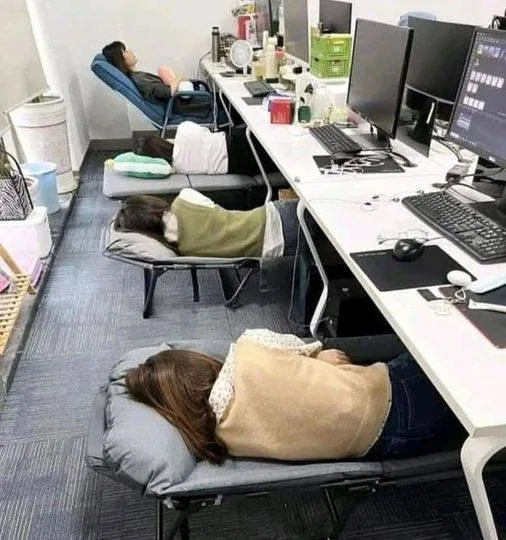In a world obsessed with hustle culture, the idea of napping at work might seem unthinkable. Yet, in places like Japan and Vietnam, taking a short snooze during the day is not only accepted but celebrated as a productivity booster. Having experienced the benefits firsthand during my time working in Vietnam, I’ve come to appreciate how a simple 30-minute nap can transform energy levels and patience, both at work and at home. This blog post explores the cultural embrace of workplace napping, its surprising advantages, and why it might be time for the rest of the world to take note.

Inemuri: Napping with Honor in Japan
In Japan, the practice of inemuri—sleeping while present—offers a unique glimpse into workplace culture. Far from being a fireable offense, napping at your desk is often seen as a sign of dedication. The logic is straightforward: an employee so committed to their job that they exhaust themselves deserves a moment of rest. This cultural norm, deeply rooted in Japan’s work ethic, allows workers to doze off briefly during breaks or even meetings, provided it’s done discreetly and doesn’t disrupt productivity.
Employers view inemuri as honorable, a testament to an employee’s diligence. A 2019 survey by the Japan Productivity Center found that over 30% of Japanese workers admitted to napping at work, with many reporting improved focus afterward. The practice reflects a balance between hard work and human limits, a philosophy that contrasts sharply with the stigma attached to napping in many Western countries, where it’s often equated with laziness.
A Personal Experience in Vietnam
My own encounter with workplace napping came while working in Vietnam. After lunch, our team would take a 30-minute break to rest, a tradition echoing the siesta-like habits common in Southeast Asia. This wasn’t just a cultural quirk—it made a tangible difference. The nap recharged us, boosting our afternoon productivity and leaving us with more energy and patience when we returned home to our families.
Scientific research backs this up. Studies, including one from NASA on pilots, show that a 26-minute nap can improve performance by 34% and alertness by 54%. In Vietnam, where midday heat can sap energy, this break aligned with the body’s natural circadian rhythm, which dips in the early afternoon. The result was a workforce that felt refreshed rather than drained, a lesson in practicality that stuck with me.
The Science Behind the Snooze
The benefits of short naps aren’t just anecdotal. A 20- to 30-minute nap—often called a “power nap”—avoids deep sleep stages, preventing grogginess and allowing for quick recovery. This aligns with the ultradian rhythm, where focus wanes after about 90 minutes of work. Research from the National Sleep Foundation highlights that napping can enhance memory, reduce stress, and even lower the risk of heart disease, making it a health investment as much as a productivity tool.
In Japan, inemuri practitioners rarely exceed 20-30 minutes, keeping the nap restorative rather than disruptive. In Vietnam, our structured break followed a similar principle, ensuring we returned to tasks with renewed vigor. This science-driven approach is gaining traction globally, with companies like Google and Nike installing nap pods to mimic these benefits.
Global Perspectives on Napping
The acceptance of workplace napping varies widely. In Spain, the traditional siesta—once a lengthy midday rest—has shortened in urban areas but retains cultural significance. In contrast, many U.S. workplaces still view napping as unprofessional, though progressive firms are shifting this mindset. Meanwhile, in countries like Italy and India, short post-lunch breaks remain common, reflecting a practical adaptation to climate and lifestyle.
This diversity highlights how cultural context shapes attitudes toward rest. In Japan, it’s a badge of honor; in Vietnam, a necessity; in the West, a growing experiment. As of August 21, 2025, discussions on X show a rising interest in nap culture, with users sharing tips and debating its workplace viability—a sign that this practice might be going global.
Why We Should Embrace Napping
The evidence is clear: workplace napping enhances productivity, mood, and health. My experience in Vietnam showed how a 30-minute break could turn a sluggish afternoon into a productive one, while Japan’s inemuri proves it can coexist with a rigorous work ethic. For employers, encouraging naps could reduce burnout and boost output—benefits that outweigh the minor adjustment to schedules.
At home, the ripple effect is just as powerful. Returning with patience and energy to spend with family, as I did, underscores the personal value of this practice. It’s a small change with big returns, challenging the notion that constant activity equates to success.
Conclusion
From the honorable inemuri of Japan to the practical naps of Vietnam, workplace snoozing offers a compelling case for rethinking our relationship with rest. My firsthand experience highlights its transformative potential, supported by science and embraced by diverse cultures. As we move through 2025, perhaps it’s time to trade the coffee break for a nap break—honoring diligence, boosting productivity, and bringing a little more peace home. What do you think—ready to give it a try?





